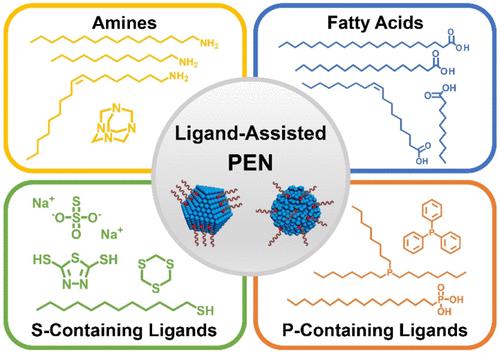当前位置:
X-MOL 学术
›
Acc. Chem. Res.
›
论文详情
Our official English website, www.x-mol.net, welcomes your
feedback! (Note: you will need to create a separate account there.)
Ligand-Assisted Phase Engineering of Nanomaterials
Accounts of Chemical Research ( IF 16.4 ) Pub Date : 2023-06-09 , DOI: 10.1021/acs.accounts.3c00121 Qinbai Yun 1 , Yiyao Ge 2 , Biao Huang 1, 3 , Qingbo Wa 1 , Hua Zhang 1, 3, 4
Accounts of Chemical Research ( IF 16.4 ) Pub Date : 2023-06-09 , DOI: 10.1021/acs.accounts.3c00121 Qinbai Yun 1 , Yiyao Ge 2 , Biao Huang 1, 3 , Qingbo Wa 1 , Hua Zhang 1, 3, 4
Affiliation

|
The synthesis of monodisperse colloidal nanomaterials with well-defined structures is important for both fundamental research and practical application. To achieve it, wet-chemical methods with the usage of various ligands have been extensively explored to finely control the structure of nanomaterials. During the synthesis, ligands cap the surface and thus modulate the size, shape, and stability of nanomaterials in solvents. Besides these widely investigated roles of ligands, it has been recently discovered that ligands can affect the phase of nanomaterials, i.e., their atomic arrangement, providing an effective strategy to realize the phase engineering of nanomaterials (PEN) by selecting appropriate ligands. Nanomaterials normally exist in the phases that are thermodynamically stable in their bulk states. Previous studies have shown that under high temperature or high pressure, nanomaterials can exist in unconventional phases which are unattainable in the bulks. Importantly, nanomaterials with unconventional phases exhibit unique properties and functions different from conventional-phase ones. Consequently, it is feasible to utilize the PEN to tune the physicochemical properties and application performance of nanomaterials. During wet-chemical synthesis, ligands binding to the surface of nanomaterials can modify their surface energy, which could significantly affect the Gibbs free energy of nanomaterials and thus determine the stability of different phases, making it possible to obtain nanomaterials with unconventional phases at mild reaction conditions. For instance, a series of Au nanomaterials with unconventional hexagonal phases have been prepared with the assistance of oleylamine. Therefore, the rational design and selection of different ligands and deep understanding of their effect on the phase of nanomaterials would significantly accelerate the development of PEN and the discovery of novel functional nanomaterials for diverse applications.
中文翻译:

纳米材料的配体辅助相工程
具有明确结构的单分散胶体纳米材料的合成对于基础研究和实际应用都具有重要意义。为了实现这一目标,人们广泛探索了使用各种配体的湿化学方法来精细控制纳米材料的结构。在合成过程中,配体覆盖表面,从而调节纳米材料在溶剂中的尺寸、形状和稳定性。除了配体的这些广泛研究的作用之外,最近发现配体可以影响纳米材料的相,即它们的原子排列,为通过选择合适的配体来实现纳米材料(PEN)的相工程提供了有效的策略。纳米材料通常以在本体状态下热力学稳定的相存在。先前的研究表明,在高温或高压下,纳米材料可以以非常规相存在,这是在本体中无法实现的。重要的是,具有非常规相的纳米材料表现出不同于常规相纳米材料的独特性质和功能。因此,利用PEN来调节纳米材料的理化性质和应用性能是可行的。在湿化学合成过程中,配体与纳米材料表面结合可以改变其表面能,从而显着影响纳米材料的吉布斯自由能,从而决定不同相的稳定性,使得在温和的反应下获得具有非常规相的纳米材料成为可能状况。例如,在油胺的帮助下,制备了一系列具有非常规六方相的金纳米材料。因此,合理设计和选择不同配体并深入了解它们对纳米材料相的影响将显着加速PEN的发展和发现适合多种应用的新型功能纳米材料。
更新日期:2023-06-09
中文翻译:

纳米材料的配体辅助相工程
具有明确结构的单分散胶体纳米材料的合成对于基础研究和实际应用都具有重要意义。为了实现这一目标,人们广泛探索了使用各种配体的湿化学方法来精细控制纳米材料的结构。在合成过程中,配体覆盖表面,从而调节纳米材料在溶剂中的尺寸、形状和稳定性。除了配体的这些广泛研究的作用之外,最近发现配体可以影响纳米材料的相,即它们的原子排列,为通过选择合适的配体来实现纳米材料(PEN)的相工程提供了有效的策略。纳米材料通常以在本体状态下热力学稳定的相存在。先前的研究表明,在高温或高压下,纳米材料可以以非常规相存在,这是在本体中无法实现的。重要的是,具有非常规相的纳米材料表现出不同于常规相纳米材料的独特性质和功能。因此,利用PEN来调节纳米材料的理化性质和应用性能是可行的。在湿化学合成过程中,配体与纳米材料表面结合可以改变其表面能,从而显着影响纳米材料的吉布斯自由能,从而决定不同相的稳定性,使得在温和的反应下获得具有非常规相的纳米材料成为可能状况。例如,在油胺的帮助下,制备了一系列具有非常规六方相的金纳米材料。因此,合理设计和选择不同配体并深入了解它们对纳米材料相的影响将显着加速PEN的发展和发现适合多种应用的新型功能纳米材料。











































 京公网安备 11010802027423号
京公网安备 11010802027423号